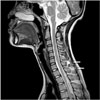This article has been
cited by other articles in ScienceCentral.
Abstract
Clay-Shoveler's fracture refers to a fracture that is solely developed on the spinous process of the cervical spine or the thoracic vertebrae. This fracture rarely occurs during sporting activities. In this case, an 18-year-old female developed the fracture on the spinous process of the 7th cervical spine and 1st thoracic vertebrae due to the repetitive practice of cheerleading. The patient's pain was improved by wearing a support device and taking an anti-inflammatory analgesic drug and muscle relaxant. Her case is being followed-up at the outpatient department.
Keywords: Lower cervical vertebra fracture, Clay-Shoveler's fracture, Cheerleader, Spinous process, Stress fracture
Even though cheerleading in Korea is not as prevalent as in Europe and America, cheerleaders' recognition is getting higher as some star cheerleaders appear on media recently. Damages during cheerleading performance frequently occur at failure of movement (15%), tumbling (15%), and falling (14%), which are mostly sprains. The frequently damaged parts are ankles (15%), collum (7%), lower lumbar vertebrae (5%), knee joint (5%), and carpal tunnel (4%).
1) Stress fracture that occurs solely on spinous process of the cervical spine is a very rare damage, which the authors observe along with literature review.
Case Reports
The patient is an 18-year-old female who visited this hospital due to a sudden cervical pain. She is freshman in college and practiced cheerleading at her club every day. The day before she visited the hospital, there was a snap while she was bending her neck, and her pain started. Because the pain hadn't been improved since then, she had to come to the hospital. On neurologic examination, there was only pressure ache around nuchal without radiating pain or muscular weakness in upper limbs. The patient showed movement limit on shoulder joint serratus and cervical flexure, extension and rotation, and visual analogue scale (VAS) was 7, which means unbearable pain.
On radiational examination, double shadow sign (ghost sign) of spinous process on the 7th cervical vertebral and the 1st thoracic vertebrae on the front and back of the cervical vertebral was observed, and the same parts of the sides of the cervical vertebral had vertical distal fracture with infraplacement (
Fig. 1). On T2-weighted sagittal magnetic resonance imaging (MRI) of the cervical vertebral, high signal intensity was observed on interspinous ligament from the 6/7 cervical vertebral to the 1/2 thoracic vertebra, which could be considered as a sprain or rupture. Edema was shown around neck muscles, but spinal cord compression didn't appear (
Fig. 2). In clinical opinion above, she was diagnosed with Clay-Shoveler's fracture caused by cervical hyperflexion due to nontraumatic indirect damages.
The patient was prescribed oral analgesic and muscle relaxant along with wearing Philadelphia Cervical Orthosis for 8 weeks. At follow-up of 1 week in the outpatient department, the patient's pain was relieved to VAS 4, and at follow-up of 6 months, the pain score was relieved to VAS 0, terminating the conservative treatment.
Discussion
Clay-Shoveler's fracture, which is a stable vertebral fracture of spinous process usually developed on 6th or 7th cervical vertebra, could occur at any parts of the lower cervical vertebral or the upper thoracic vertebra. The disease was often developed on Clay-Shovelers who scooped up soil with long shovels and delivered it on their shoulders in 1930s in Australia, and it accompanies sudden pain between the both sides of the shoulder blades and on the cervical spine without direct external injuries. As industrialization started, the disease decreased in frequency, but it has been on the rise due to increasing car accidents and pedestrian traffic accidents. The damage mechanism includes direct external injury on the posterior region of neck, cervical hyper-flexure, hyperextension damage and shear force by trapezius and rhomboid, which are attached muscles of spinous process. Isolated injury of spinous process occurs at T1 most frequently followed by C7, T2, T3, and C6.
23)
According to document reviews, cases of Clay-Shoveler's fractures that were caused not by single high energy trauma, but by repeated stress to the cervical vertebra have been reported. Such cases included fractures of spinous process of the cervical vertebral or the thoracic vertebrae 1 case of volleyball, 1 case of lifting, and 2 cases of golf. All the cases were stress avulsion fractures through trapezius and rhomboid. It also seems that in this case shearing force was applied on C7 and T1 spinous process through trapezius and rhomboid caused by repetitive cervical hyper-flexure, hyperextension movements resulting in stress avulsion fracture.
4567)
The most common symptom of isolated fracture of spinous process is dolorosa. Cephalic and upper limb radiating pains occur along with tenderness on the posterior region of neck. Radiography is the most useful examination method, which enables observation of fractured distal spinous process's infraplacement on the lateral radiograph. The state of spinal canal and ligament injury information can be acquired via computed tomography and MRI, which allows of easier diagnosis of accompanied damage.
Most cases are stable fractures, and patients can recover with conservative therapy, such as taking antiinflammatory analgesic drug and wearing Philadelphia Cervical Orthosis for 4 to 6 weeks. However, in case the damage is extended to intervertebral disks, evaluation about instability of cervical spine and spinal cord injury is necessary. In rare cases, fragment excision is performed if pain is too severe or normal life is restricted.
As this case shows, a cervical sport injury that occurs without direct external force is so rare that it can be overlooked easily. Therefore, proper treatment should be performed by attentively listening to patients' medical history and by precise diagnosis using meticulous clinical examination and radiography.






 PDF
PDF ePub
ePub Citation
Citation Print
Print



 XML Download
XML Download